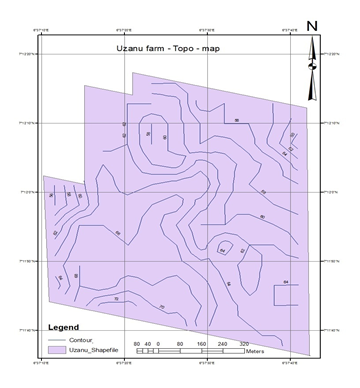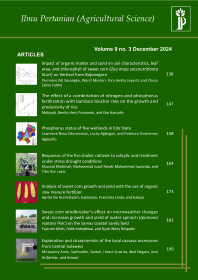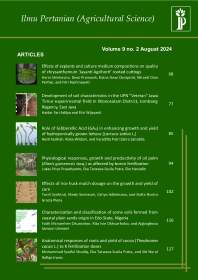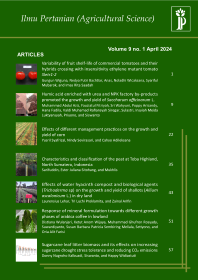
Study of land suitability for rubber and cashew in the derived savanna zone of Edo State, Nigeria
Lucky Agbogun(1*), Aigboghosa Samson Umweni(2), Henry Kadiri(3), Faith Ehinomhen Okunsebor(4)
(1) Department of Soil Science and Land Management, Faculty of Agriculture, University of Benin P.M.B 1154, Ugbowo Lagos Rd, Benin City, Edo State, Nigeria
(2) Department of Soil Science and Land Management, Faculty of Agriculture, University of Benin P.M.B 1154, Ugbowo Lagos Rd, Benin City, Edo State, Nigeria
(3) Department of Soil Science and Land Management, Faculty of Agriculture, University of Benin P.M.B 1154, Ugbowo Lagos Rd, Benin City, Edo State, Nigeria
(4) Department of Soil Science and Land Management, Faculty of Agriculture, University of Benin P.M.B 1154, Ugbowo Lagos Rd, Benin City, Edo State, Nigeria
(*) Corresponding Author
Abstract
This study attempted to assess the soil suitability in the derived savanna zone of Edo State, Nigeria for the cultivation of some tree crops. The research specifically aimed to evaluate soil suitability for cashew and rubber supported by suitability maps for both crops. In terms of land suitability evaluation, mapping units 1 and 2, with an area coverage of 27.4 ha of the entire research area (100 ha) were found to be marginally suitable (S3) for rubber cultivation but moderately suitable (S2) for cashew. Mapping unit 3, with area coverage of 38 ha was found to be currently not suitable (N1) for rubber but marginally suitable (S3) for cashew cultivation. Mapping unit 4 representing area coverage of 34.7 ha was found to be permanently not suitable (N2) for rubber cultivation but marginally suitable (S3) for cashew. Thus, technically, rubber can only be cultivated in that land at marginal level with an expected productivity of 27.4 ha (27.4 %). Cashew can be cultivated at moderate and marginal levels with an expected yield of 27.4 ha (27.4 %) and 72.6 ha (72.6 %), respectively, of the total land area. Thus, the preferred crop for the studied is cashew. It is recommended that for any significant investment in cultivation of this crop, the priority is the moderate levels with an expected productivity of 27.4 ha or 27.4 % of total land area.
Keywords
Full Text:
PDFReferences
Anderson, F. and Ingram, I. (1993). Tropical soil biology and fertility. A hand book of methods. 2nd ed. Wallingford, UK: C.A.B. International, pp. 221.
Behzad, M., Albaji, M., Papan, P., Nasab, S.B., Naseri, A.A., and Bavi, A. (2009). Qualitative evaluation of land suitability for principal crops in the Gargar Region, Khuzestan Province, Southwest Iran. Asian Journal of Plant Sciences, 8(1), pp. 28-34.
Bhermana, A., Sunarminto, B.H., Utami, S., Gunawan, T. (2013). The combination of land resources evaluation approach and GIS application to determine prime commodities for agricultural land use planning at developed area (a case study of central kalimatan province, Indonesia). Journal of Agricultural and Biological Science, 8(12), pp. 771-784.
Bremner, J.M. and Mulvaney, C.S. (1996). Nitrogen-total. In: Page, A.L., Miller, R.H., Keeney, D.R. eds., Methods of Soil Analysis, 2nd ed. Madison, Wisconsin: American Society of Agronomy, Soil Science Society of America, pp 595-624.
Dent, D. and Young, A. (1981). Soil survey and land evaluation. 3rd ed. London, UK: George Allen and Unwin Publishers, pp. 121-132.
Djaenudin, D., Marwan, H., Subagjo, H., and Hidayat, A. (2003). Petunjuk teknis evaluasi lahan untuk komoditas pertanian. 1st ed. Bogor: Balai Penelitian Tanah, pp. 132.
Food and Agriculture Organization. (1984). Land evaluation for forestry. 2nd ed. FAO Forestry Paper 48. Rome: FAO, pp. 123.
Food and Agriculture Organization (1976). Framework for land evaluation. 4th ed. FAO Soils Bulletin No 32. Rome, Italy: Food and Agriculture Organization, pp 32-54.
Gee, G.W. and Or, G. (2002). Particle size analysis. In: Dane, J.H. and Topp, G.C. eds., Methods of Soil Analysis part 4, Physical Methods. Book series No. 5. Madison, WI: ASA and SSA, pp. 225-293.
Mclean, E.O. (1982). Soil pH and lime requirement. In: Page, A.L. ed., Methods of Soil Analysis Part 2, Chemical and Microbiological Properties. Madison: American Society of Agronomy, Soil Science Society of America, pp. 199-224.
Mongkolsawat, C. and Putklang, W. (2010). An approach for estimating area of rubber plantation: Integrating satellite and physical data over the Northeast Thailand. Proceeding of 31st Asian Conference on Remote Sensing 2010, 2, pp. 1228-1234.
Olowojoba, S.O., Kappo, A.A., Ogbole, J.O., Alaga, A.T., Mohammed, S.O., and Eguaroje, E.O. (2016). Land suitability and evaluation for the production of cassava in Akoko-Edo L.G.A. of Edo State using geo-technology techniques. Greener Journal of Agricultural Sciences, 6(2), pp. 059-068.
Olsen, S.R. and Sommers, L.E. (1982). Phosphorus. In: Methods of Analysis Part 2. 3rd ed. Madison Winscosin: America Society of Agronomy, pp. 15-72.
Page, A.L., Miller, R.M. and Kenny, D.R. (1982). Methods of soil analysis. No 9, Part 2, Chemical and microbial properties. 2nd ed. Madison, Wisconsin, USA: American Society of Agronomy, pp 102-115.
Peder, A., Margaret, R.G., Herald, S., and Wang, B. (2001). A decision-making tool for land evaluation in the developing countries. [online]. Available at: https://cartogis.org/docs/proceedings/archive/auto-carto-london-vol-2/pdf/a-decision-making-tool-for-land-evaluation.pdf. [Accessed 28 July 2021].
Peter, K.D. and Umweni, A.S. (2021). Evaluation of land suitability for citrus cultivation in Khana Local Government Area of Rivers State, Southern Nigeria. Ilmu Pertanian (Agricultural Science), 6(1), pp. 1-9.
Peter, K.D. and Umweni, A.S. (2020a). Morphological and physical properties of development from coastal plain sands and alluvium in Khana Local Government Area of Rivers State, Southern Nigeria. African Journal of Sustainable Agricultural Development, 1(1), pp. 1-9.
Peter, K.D. and Umweni, A.S. (2020b). Characterization and classification of soils developed from coastal plain sands and alluvium in Khana Local Government Area of Rivers State, Southern Nigeria. Direct Research Journal of Agriculture and Food Science, 8(7), pp. 246-253.
Remison, S.U. (2005). Agriculture as the way. Inaugural Lecture. Ambrose Alli University.
Rossiter, D.G. (2001). Land evaluation processes draft copy. M.Sc Thesis. Cornell University College of Agriculture and Life Science, Department of Soil, Crop and Atmospheric Sciences.
Rossiter, D.G. and Van Wambake, A.R. (1997). Automated land evaluation system ALES Version 4.65 User’s Manual. Ithaca: Cornell University, Department of Soil, Crop and Atmospheric Sciences (SCAS) Teaching Series.
Soil Survey Staff. (2014). USDA keys to soil taxonomy. 10th ed. Washington, DC: National Resource Conservation Service, US Dept. of Agriculture, pp. 332.
Sys, C. (1985). Land evaluation part 1,11 and 111. Ghent: State University of Ghent, Belgium International Training Centre for Post Graduate Soil Scientist, pp 221-258.
Tan, K.H. (1996). Soil sampling, preparation and analysis. 4th ed. Madison Avenue, New York: Mercel Dekker Inc. 270, pp 22-48.
Thomas, G.W. (1982). Exchangeable cation. In: Page, A.L. et al. eds., Methods of Soil Analysis. Part 2, Agron. Monograph, 9. 2nd ed. Madison, Wisconsin: American Society of Agronomy and Soil Science Society of America, pp. 159-165.
Tomczyk, A., Sokołowska, Z., and Boguta, P. (2020). Biochar physicochemical properties: pyrolysis temperature and feedstock kind effects. Re. Environ. Sci. Biotechnol., 19, pp. 191–215.
Tyagi, S. (2003). Agricultural land use planning using remote sensing techniques in part of South Goa (India). Proceedings of the 21st International Cartographic Conference, pp. 1254-1259.
Weppa Wanno Farms. (2013). Annual weather reports. pp. 67-95.
Article Metrics
Refbacks
Ilmu Pertanian (Agricultural Science) ISSN 0126-4214 (print), ISSN 2527-7162 (online) is published by Faculty of Agriculture Universitas Gadjah Mada collaboration with Perhimpunan Sarjana Pertanian Indonesia (PISPI) and licensed under a Creative Commons Attribution-ShareAlike 4.0 International License.













